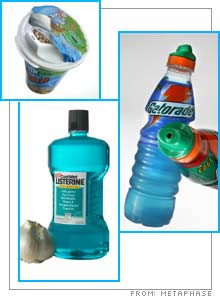|
Packaging that moves product
Design firm Metaphase creates products that look good, work better--and sell more.
Good product design can boost sales, and a small outfit called Metaphase has the track record to prove it. Consider the company's transformation of Listerine's 2.1 liter vat of mouthwash, containing of a product best known for its unpleasant taste. Last year, after Pfizer (Research) introduced a redesigned clubstore-size bottle of Listerine, sales grew by double digits.
Keith Wilmot, Pfizer's director of sales innovation, credits the uptick to Metaphase Design Group, the St. Louis-based firm that created the new product packaging. Metaphase replaced the old whiskey-bottle-style container with a design that features a built-in hand grip and a larger cap. Design with a difference
The grip makes the bottle easier to lift, while the big mouth encourages buyers to chug straight from the container. It used to take about six months for consumers to finish off jumbo bottles of mouthwash. Now they empty them more quickly—which means more frequent trips to the store to restock. "There's been an actual change in usage behavior," Wilmot says. Metaphase-designed products look whimsical, but their curves, bumps, and grooves usually have a practical purpose. Bryce Rutter, an industrial designer with a Ph.D. in kinesiology, set out in 1991 to create a design firm that would be guided by the nuances of practical physiology. It has since grown to 26 employees, and the firm's in-house expertise spans fields as diverse as anatomy, cognition, and psychophysics. Small company, big clients
Revenues at privately held Metaphase have grown in tandem with its expanding client roster, which now includes Bayer (Research), Dell (Research), Kellogg (Research), Kraft (Research), and PepsiCo (Research). Metaphase appeals to clients for a simple reason: Ergonomic design can improve sales. Consider the bottle Metaphase designed in 1998 for PepsiCo subsidiary Gatorade. Metaphase's research showed that there are two types of athletes: those who like to squeeze a sports drink from the bottle, and those who prefer to suck it out. To satisfy both groups, the new bottle featured a choke-hold grip and an ergonomic mouthpiece that fits the user's lips. It was easier to use, and it stood out on crowded store shelves—factors Gatorade cites to explain why sales jumped 25 percent after the bottle was introduced. People watching
Rutter believes that the best way to find out what a product should do is by watching people use it in the real world. When Solo Cup hired Metaphase to redesign its disposable plates, the firm threw a series of picnics and photographed guests as they piled on the food. "We looked at it from a purely biomechanical standpoint," Rutter says. "How were people carrying their plates? What's the best way to hold it?" The result was the SoloGrips line of disposable plates, notable for their deep walls and indented hand grips. Solo marketing director Kim Healy says SoloGrips sales have been growing at a double-digit pace. Recasting the coffee cup
Small details can make a big difference to consumers. When Solo hired Metaphase to design a new lid for carryout coffee cups, the team spent eight months scrutinizing the physiology of hot beverage consumption before settling on a new design with a drinking hole that can be opened or closed with one hand. Although the new Traveler Plus lid costs more to produce, it's now the standard coffee topper at 7-Eleven convenience stores, where company execs say the added expense is offset by increased customer satisfaction. The design of Traveler Plus has even earned it a place in New York's Museum of Modern Art. Clever designs can also become the foundations for entirely new products. To feed harried commuters, Metaphase created the Drink 'n Crunch single-serving container for Kellogg. With an inner cup of cereal ringed by an outer cup of milk, the package eliminates the need for spoons, while the tapered shape lets motorists keep an eye on the road when tilting the cup back. None of this comes cheap—the firm charges anywhere from $50,000 to $2 million for a complete design contract. Though he declines to provide specifics, Rutter says Metaphase revenues have more than doubled since 2000 and project volume has increased by 60 percent—a lucrative trend that should be easy for any designer to grasp. ____________________ Read more about small business here.
David Goldenberg is a writer in San Francisco and an editor at Gelfmagazine.com. |
|


